Italy Army Day !
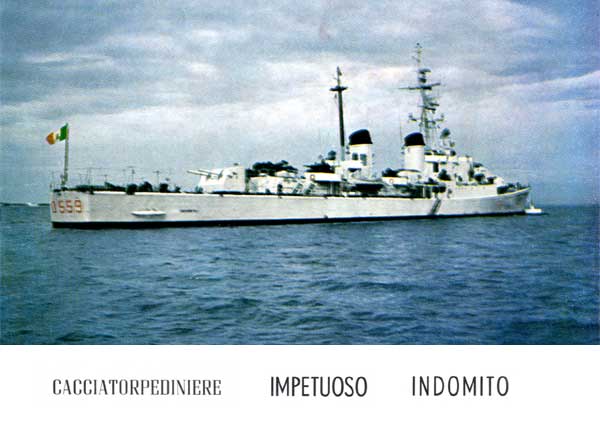
The Impetuso or Indomito class depending on the authors were two early cold war destroyers built for the Marina Militare, the first large warships in years. They were the fruit of WW2 lessons and recent NATO guidelines and if the base design started from the WW2 Medaglie d’Oro class they ended almost as Italian take of the Gearing class destroyers, with the same armament and electronics. The powerplant was also US-built, as main guns. They only had limited upgrades and served until 1983. https://naval-encyclopedia.com/cold-war/italy/impetuoso-class-destroyers.php #coldwar #d558impetuoso #d559indomito #marinamilitare #italiannavy
Rebuilding a destroyer fleet
The Regia Marina disappeared as the Republic was proclaimed in January 1, 1948, replaced by the Marina Militare, name which is still actual. This era was rife with political uncertainty, and the new navy started with the ships not sunk during the war or given as war reparations. As we saw in the early phase of the Marina Militare, the 1940s came to an assessment of surviving destroyers, which a large part were chosen for transfer as war reparations.

Part of the ones kept by Italy, the Granatiere (D550) was modernized and extensively used until 1958, like the Carabiniere (1965). Credits Marcello Rigoso src
In cruisers, there were five available, but for destroyers and torpedo boats, from a fleet of c160 ships, a very few were left. In all, five destroyers could be modernized (the other surviving ones were transferred to France and one scrapped): Grecale (Maestrale class), Artigliere, Carabiniere, Granatiere and Fuciliere (Soldati). They obtained new bridges and Modern sonar, radar, new DC racks and DCTs, being later reclassified as frigates.
A new naval initial naval plan started to determine the need of the Navy for 1949, to be assumed by existing naval yards, repaired with US funds. Critically, by 1949, The Marina Militare joined NATO. With Marshall plan funds now available, the New 1950 naval Plan planned a five-year reconstruction of European shipyards, accompanied by the procurement of a 6,000 ton cruiser, two 4,000 ton AA cruisers, and six versatile 2,500 ton destroyers for the surface fleet.
The latter war to be filled by both rebuilt ships seen above, and a new class of Italian-built destroyers, planned to be laid down in 1952.
These became the Impetuoso class.
They would be followed by the Impavido class in 1957, planned as gun armed, then reconverted as missile destroyers, among the very first in Europe. Later in 1969 some were transferred under MDAP, the Fletcher DDE of the Lanciere class (Lanciere, Fante, Geniere), realizing a plan of five modern destroyers. The renewal came with the missile-armed Audace class (1971) and De La Penne class in 1989.
But the initial two classes, four ships in all, mirrored the economic reality of Italy: France on the other hand was able to built 17 “classic” destroyers, all gun-armed. They launched in 1960 their first missile-armed ones for ASW warfare (La Galissonière), whereas Italy launched its own AAW Impavido class in 1962. France’s new Suffrens (1965) AAW/ASW missile DDs were much more larger and capable, and Italy had its own in 1971. Comparisons stopped there. France had still an Empire and a deterrence to create and maintain. Any comparison to interwar rivalry was nullified by the fact both were in very different economic shape and in NATO.
Design of the Impetuso class
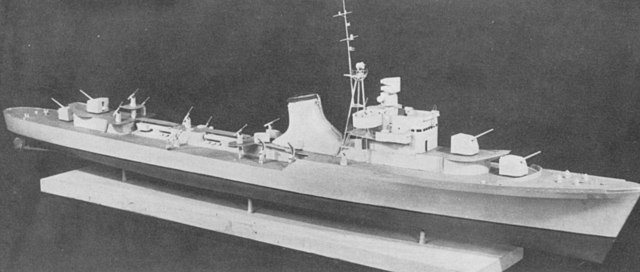
The unbuilt Commandante Medaglie d’Oro (1942), here the 1st serie. The new 1950 design partly retook its hull.
General Overview
Due to their desired characteristics, they were on paper intended for anti-ship (ASuW) and anti-submarine (ASW), for coastal bombardment actions and for escorting convoys and naval formations. The question of the powerplant was solved quickly, the admiralty wanted something effective for both speed and range. Armament was kept to artillery at that stage, the onl true innovation neing the new 105mm rocket launchers and initially two triple 533mm torpedo launchers, plus a long-range depth charge launcher, and four short-range bomb launchers plus depht charge thrower.
Development
Italy’s first postwar design was defined relatively late, since it lacked the industrial capacity and shipyards to take any order (in 1944-45 between allied bombings and German destructions, they were unable to operate for years). It was simpler and cheaper to modernize existing ships. But for a new one planned to start in 1952, the Admiralty was able to retake an existing, unrealized design, the “Commandante Medaglie d’Oro“, 21 ordered during the war but none completed: At the armistice in September 1943 only nine units had been laid down and of these only one, the Commander Margottini, was launched, the rest were canceled following the German occupation of Italy. The ones most advanced were BU on slip, as their design was considered already obsolete. Unlike previous class, they had four single dual purpose guns and a radar.
In 1948, the same admiralty started to look at teh USA for the latest in destroyer design, and their appreciation of the recent Gearing class, starting a mix between the two.
As the design was finalized in 1949, the hull was a repeat of the “Commandandi” and size and general configuration, but now made flush-deck. The armament was completely changed and determined to be US-provided and standardized, as well as the electronics. This pattern was confirmed in 1950 and determined many aspects of the rebuilt Marina Militare in the fifties and early sixties.
Final design: Hull and general arrangements
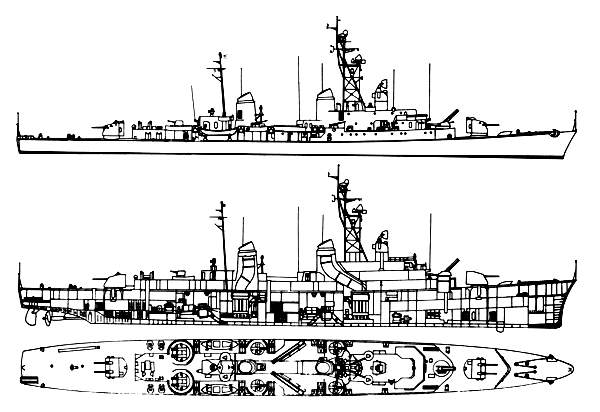
The final design was to be displacing 2,775 tons standard and 3,810 tons full load (versus 2,600 t/2,950 t on the comandanti), a Length overall of 127.6 m (418 ft 8 in), and between perpendiculars of 123.4 m (405 ft), beam of 13.2 m (43 ft 4 in) and Draught of 4.5 m (14 ft 9 in), again close to the 120,1 m x 12,2 m x 3,2 m of the WW2 design, but enlarged. The flush deck was clearly inspired by the Gearing class, albeit it is unknown how much consideration went to its adoption rather than a more common forecastle one. The next destroyers all kept this configuration.
The armament (see later) was fixed as a compromise, with two twin 5-in/38 turrets (fore and aft), an ASW rocket launcher and just two torpedo tubes, almost an afterthough, plus a generous provision of 40 mm Bofors-licenced Breda guns in various mounts. The complement was 315 personnel, more than the 272 of the “comandanti”, but there were comparatively limited electronics (Fufo radar and sonar) and a weaker armament. We will go back in the future on the Comandanti on a dedicated post which will conclude the italian DD tree.
The superstructures were designed around these:
The profile was unlike any previous Italian destroyer. Two funnels, one forward derrick mast for radars and a light pole recalled modernized British and US destroyers, while the large superstructure had its base extending up to the hull’s beam, with a long but low bridge structure, comprising an enclosed with open bridge section in front, also recalling US designs from the late Fletcher class and following Sumner/gearing. The single fire control system was placed higher up. The unique, large tripod lattice mast supported practically all the electronics.
The aft superstrture went aft of the forward beam-wide deck structure, down to the aft 5-in/38 mount. The triple TT banks were placed not on decks but higher up on the deck structure amidships while the quad Breda 40mm were located on the beam and platform wings for the twin, fore and aft of the second funnel. There were two service boats under davits installed abaft the structure located behind the aft funnel, supporting the pole mast. The tubes were fixed, located in the beam and tailored to lauch heavy ASW/AS torpedoes. This was a more advanced feature compared to French DD designed for example, which initially still had up to four TT triple banks.
Overall the bridge had low a weight repartition advantaged stability although the ships seemed “crowded”, less than German designs, but more than French 1950s designs.
Probably the closest in general design philosophy were the Spanish Oquendo class of 1963, albeit the Italian designs were ten years earlier and more advanced in many aspects.
As for protection, it included not armour but a robust below waterline compartimentation. The machinery spaces were welle separated, and bulkheading went up to the main deck as US practice, meaning it was impossible to communicate inside the ship but from the main weather deck. Access to each section were separated, from above.
Powerplant
The Impetuoso class was probably the least innovative in its repeat of trusted steam turbines solutions. The “comandati” planned three boilers for each of the two steam turbines (licenced Parsons) for 60.000 hp, 35 knots and a range of 3.300 nm at 20 knots. The Impetuoso design change the configuration by keeping the geared steam turbines but adopting four Foster Wheeler boilers, two per turbines, both with a much larger capacity and supeheated steam, now providing 65,000 hp (48,000 kW) which for a larger hull meant still 34 knots (63 km/h; 39 mph) and a range of 3,000 nmi (5,600 km; 3,500 mi) at 16 knots (30 km/h; 18 mph). Exhausts were truncated in two separate funnels, also partly due to the adoption of widely separated and alternated boilers and turbine rooms for survivability, also adopted from US practices.
This powerplant was repeated on the next two classes, but at last CODOG for the 1980s generation.
Armament
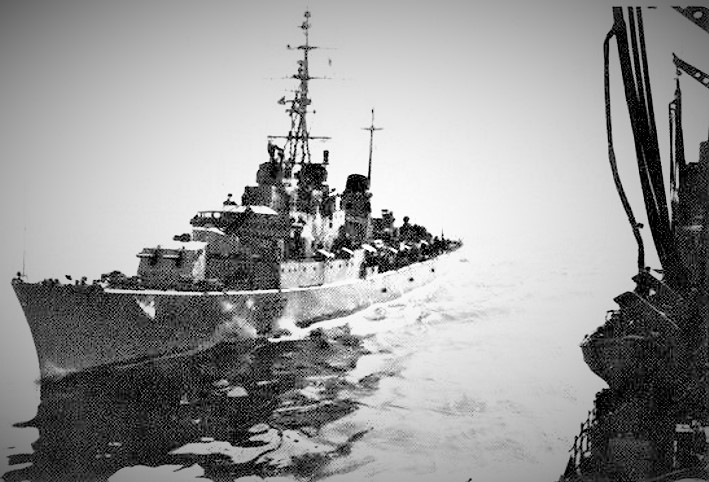
At that stage, a gun-armed consideration was the only realistic. In 1950 missile developments were still in its infancy, although US and British trials were known. However the new trend launched in 1940 was of dual purpose guns as a factor multiplier, the ship being able to perform the rounded AS, AAW and ASW tasks required by fleet escort duties. Statistics clearly shown that ship-to-ship engagement was no longer the core metric, but aviation was definitely a factor. The USN losses by kamikaze were clear enough on this point, and the submarine threat, especially with promises of the Type XXI design revolution was as present as ever. Marshall plans funding given extra leverage to the US withing NATO to “suggest” the 5-in (127 mm) caliber as stanndard at this point, and it was virtually adopted by all nations bar Britain. Even more, Spanish, German and Italian destroyers were to be equipped with the 5-in/38 caliber. France also adopted it but with their own guns. There were still immense stockpiles of it available.
Main: 2×2 127mm/38
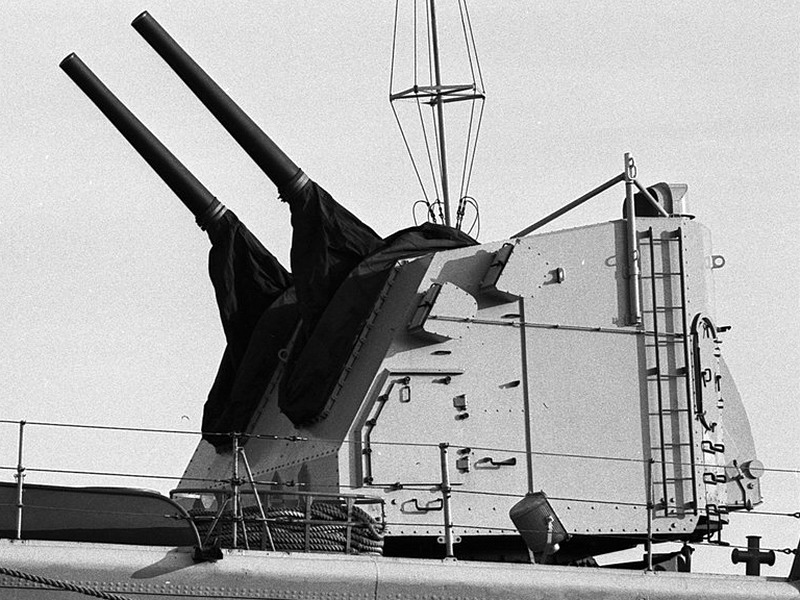
The adoption of stock US 5-inch (127 mm)/38 caliber guns in two twin-gun turrets was a considerable saving in time and development cost, and Italy had probably the best dual-purpose ordnance of WW2, still valuable in the 1960s despite the arrival of modern jets. Between its precise radar guidance and fuses, it was still a very potent armament system. Caracteristics were unchanged compared to the US models, there were essentially Mark 12 assembly guns in Mark 38 Mod 0 enclosed twin turrets, same standard as all late US destroyers, cruisers etc.
In short: −15° to +85°, 15 rpm, Muzzle velocity 2,600 ft/s (790 m/s), range 20 km.
They were guided by a modified Mark 37 FCS topped by the postwar SPG-25 radar antenna, and backed later by SPG-34 fire control radars.
305 mm Menon ASW mortar
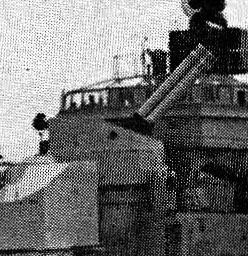 Similar to some british systems developed in the immediate post-war years, this 12-inches ASW mortar was developed from 1950, produced 1956-1960, in service until the 1980s on these destroyers as well as the contemporary Centauro and Bergamini-class frigates. It needed a Crew of 3, fired a 160 kg (350 lb) shell from three barrels at max 1,500 yd (1,372 m) range. It was a rotating system which range was adjusted by a gas valve. It fired 21 rounds in 70 seconds over an area of 90 x 180 square yards (75 x 151 m2). Each 12-in warhead was a depht charge with single setting. Later appeared the The K 113 (seven-round pattern, loaded automatically from a cylinder).
Similar to some british systems developed in the immediate post-war years, this 12-inches ASW mortar was developed from 1950, produced 1956-1960, in service until the 1980s on these destroyers as well as the contemporary Centauro and Bergamini-class frigates. It needed a Crew of 3, fired a 160 kg (350 lb) shell from three barrels at max 1,500 yd (1,372 m) range. It was a rotating system which range was adjusted by a gas valve. It fired 21 rounds in 70 seconds over an area of 90 x 180 square yards (75 x 151 m2). Each 12-in warhead was a depht charge with single setting. Later appeared the The K 113 (seven-round pattern, loaded automatically from a cylinder).
533mm TTs
Initially two banks of three of these, then this was discarded and instead, fixed tubes to fire homing torpedoes were installed. It was likely at first the 53.3 cm (21″) Si 270/533.4 x 7.2 “M”
of ww2 (3,748 lbs./1,700 kg, 23 ft. 7 in./7.200 m, 595 lbs. (270 kg) PL, Wet-heater R 4,400/8,750/13,100 yards/46/35/29 knots) or the US postwar 21″ (53.3 cm) Mark 39, but i have no info on this.
It was unlikely upgraded to the 21″ (53.3 cm) Cangaro (“Kangaroo”) of 1965 since these tubes were removed in 1968.
324mm ASWTTs
From 1968 onwards: Placed close to where the former fixed tubes on the structure deck. Fired the Mark 44 torpedo.
The latter weighted 425 lbs. (193 kg) for 100 in (2.540 m) long, carrying a 75 lbs. (34 kg) HBX-3 warhead to 6,000 yards (5,490 m)/30 knots, powered by Electric-Battery, seawater and using Helix search, active acoustic guidance.
AA: 16x 40mm/56
A powerful armament for any WW2 standard destroyers, it was inspired by late WW2 Pacific experience showing only the 40 mm Bofors was effective.
Repartition was as follows:
-Two quad mounts 40mm/60 Mk 4 aft,
-Two twin mounts 40mm/60 Mk 1,2 abaft aft funnel,
-Two twin mounts 40mm/60 Mk 1,2 abaft fore funnel
They were kept until the ships were discarded in 1983 but likely would have been removed if the 1970s refit (127mm/54 forward, Tartar aft.) would have taken place.
Depth charges
In addition to a long-range depth charge launcher, there were four short-range DC throwers and a depth charge rack aft, probably “Gatteschi” type.
Sensors (as built)
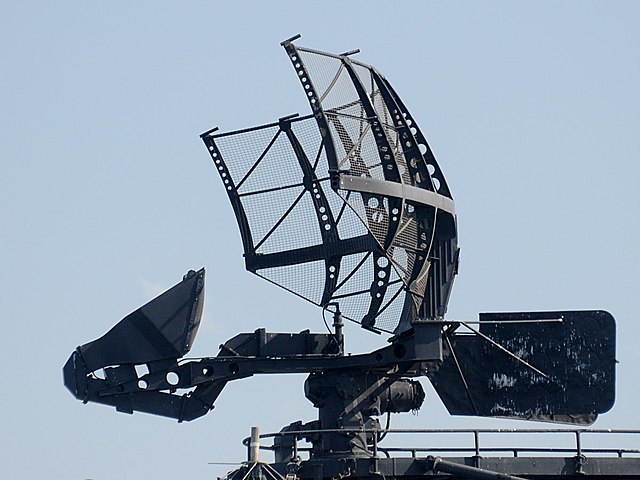
SPS-6: Bendix 500 kW 1948 2D L Band (RA 130-260 km) air search
SG-6B: surface search radar, S-Band with A-scopes, PPI displays, could detect periscope up to 10,000 yards.
4x SPG-34: Parabolic detector for 40mm AA, X-Band FCR for Mk 57 gun director/Mk 63 control system
Mk 25 radars: Mark 37 director main FCR, 9,000 MHz X-Band PRF 2 000 Hz pw 0.2 µs, bw 1.3° RA 45 km resolution 36 m
SQS-11 sonar: 1951 A hull-mounted, search/attack sonar, FRC 25.5 KHz.
See notes for upgrades.

Conway’s profile. Author’s HD one in preparation.
⚙ specifications |
|
| Displacement | 2,775t standard, 3,810t full load |
| Dimensions | 127.6 x 13.2 x 4.5 m (418 ft 8 in x 43 ft 4 in x 14 ft 9 in) |
| Propulsion | 2 shaft geared turbines, 4× Foster Wheeler boilers, 65,000 hp (48,000 kW) |
| Speed | 34 knots (63 km/h; 39 mph) |
| Range | 3,000 nmi (5,600 km; 3,500 mi) at 16 kn (30 km/h; 18 mph) |
| Armament | 2×2 127 mm/38, 16x 40mm Bofors, 305 mm Menon ASWM, 2×3 324 mm ASWTTs Mark 44 torpedoes |
| Sensors | SPS-6, SG-6B, SPG-25 and SPG-34 FCR, SQS-4 sonar |
| Crew | 315 |
Career of the Impetuoso class
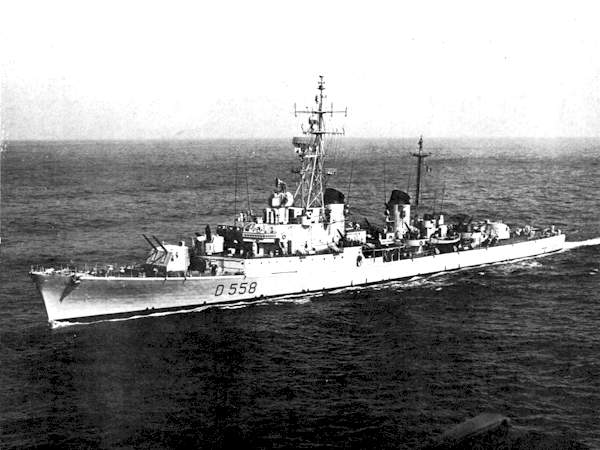
Construction time was relatively long for these ships, six years from keel laying to commission. It should be put in perspective to the situation of Italian yards in 1950 and of lack of skilled workers and recent experience. This was not unlike in other European countries at the time, but above the average. As years passed on, this was improved, down to five years for the next classes, which complexity progressed much as they were missile armed and hosted both new armament and electronics at each generation.
 D 558 Impetuoso
D 558 Impetuoso
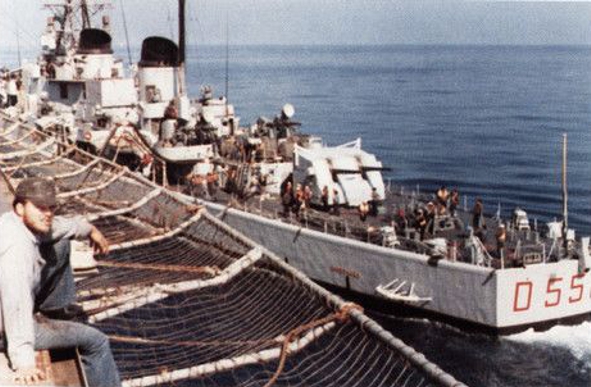
Impetuoso refuelled by USS Kalamazoo (AOR-6) in 1977 during a NATO exercise
D 558 Impetuoso was ordered to the Cantieri del Tirreno at Riva, Trigoso in 1952. She was launched in 1956 and completed, commissioned in 1957. The destroyer (still called “cacciatorpediniere” at thet stage, meaning “counter-torpedo boat(destroyer)”) Impetuoso had for motto: Ad aspera impetus. She was the third to bear this name after a 1914 destrouer and a Ciclone class TB which which
collected survivors of the battleship Roma immediately after her sinking.
No service record found so far.
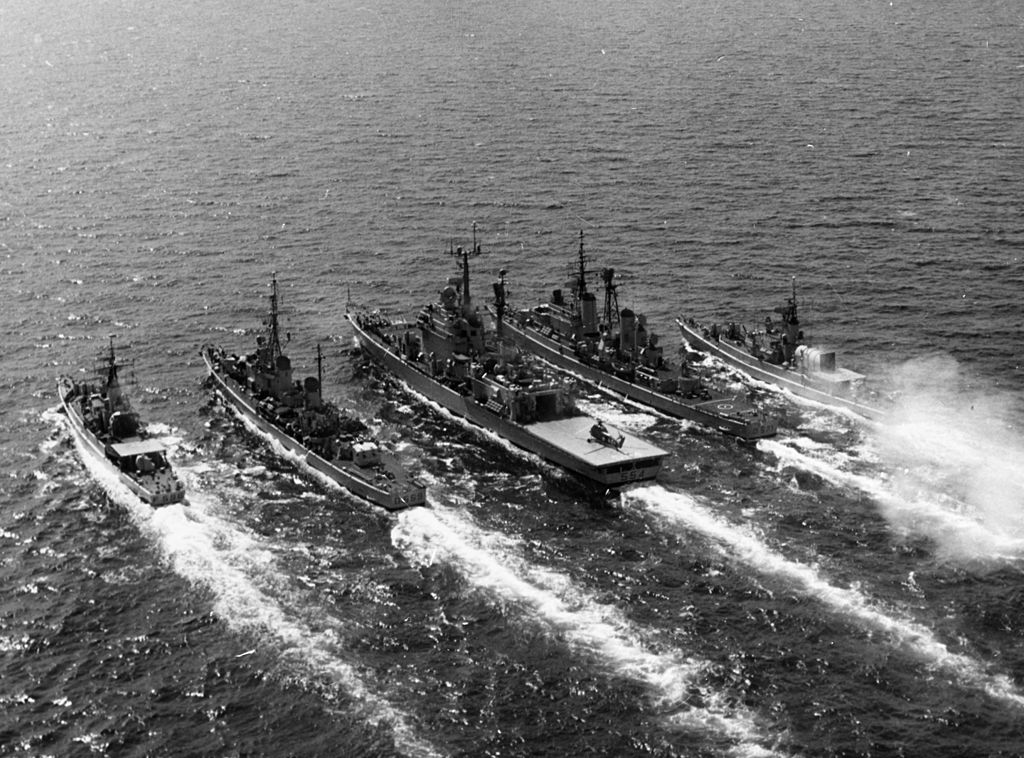
Escorting the missile cruiser Caio Duilio in the 1970s
Modifications: A major reconstruction proposed in the late 1960s planned a single lightweight 127mm/54 forward and Tartar aft, to put them to the Impavido standard.
Instead, they had their two single 533mm TTs removed as the ww2 SQS-11 sonar an two triple 324mm ASW TTs installed coupled with the new SQS-4 sonar.
In late 1970s Impetuoso was the only of the two fitted with a WLR-1 and SLQ-A ECM suites.
She was decommissioned on 1983 like her sister.
 D 559 Indomito
D 559 Indomito
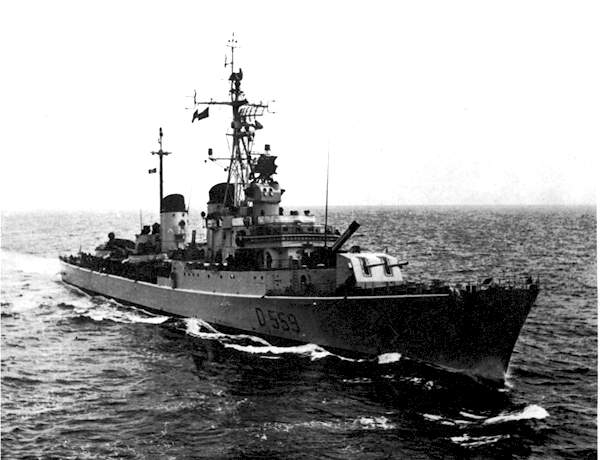
D 559 Indomito was ordered to Ansaldo Livorno, laid down in 1952, launched in 1955 and completed 1956. The destroyer Indomito (motto: Velut nomen sic corda) was the third of the name after a 1913 destroyer and Ciclone class torpedo boat (later a war reparation to Yugoslavia as Boikovo).
No detailed service record found so far.
During the disastrous Agadir earthquake (March 1960) she was carrying out a NATO exercise in the upper Tyrrhenian Sea when diverted to Civitavecchia, to take on food and medicines and sail to offload these to Agadir an then to Casablanca at 32 knots.
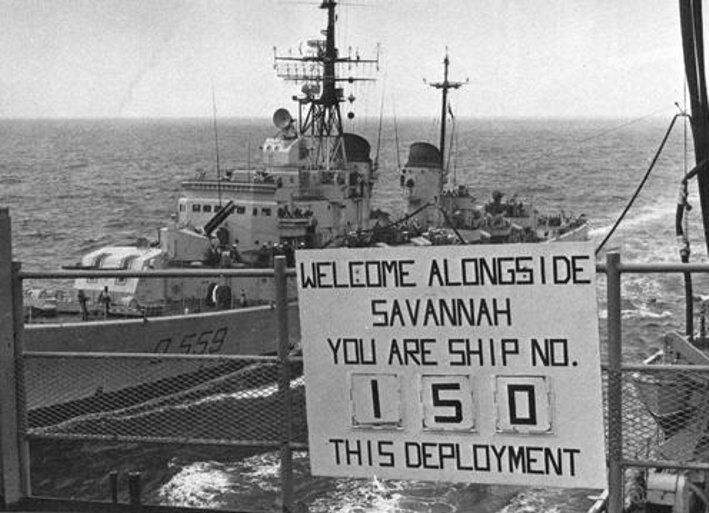
She was modernized the same way as her sister (single TT removed, two triple ASW TTs added and sonar modernized). Hoever unlike her sister she was not updated with WLR-1 and SLQ-A ECM suites, but she was kept into service performing NATO fleet exercises until she was decommissioned in 1983. These destroyers were replaced essentially by the new generation of Frigates.
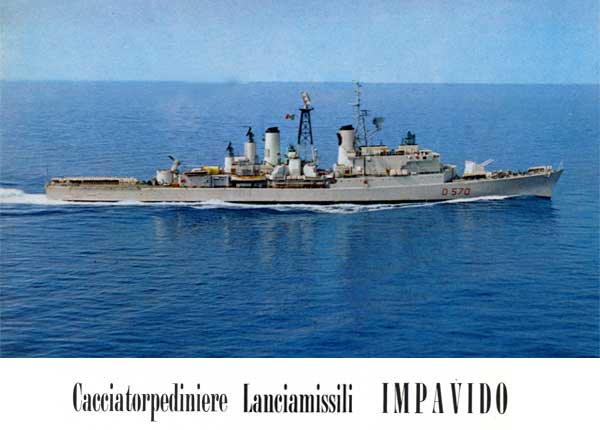
The next Impavido class
Read More/Src
Books
Links
on en.wikipedia.org
Classe_Comandanti_Medaglie_d%27Oro
seaforces.org
navypedia.org
on marina.difesa.it
impavido on marina.difesa.it
indomito on marina.difesa.it
on naviecapitani.it
Videos
Model Kits
Not Much. On shapeway, a 2400 scale for tabletop games: https://www.shapeways.com/product/T4T8PSR9L/its-impavido-class-ddg-1-2400?optionId=58482194&li=marketplace
Hansa 1/1250

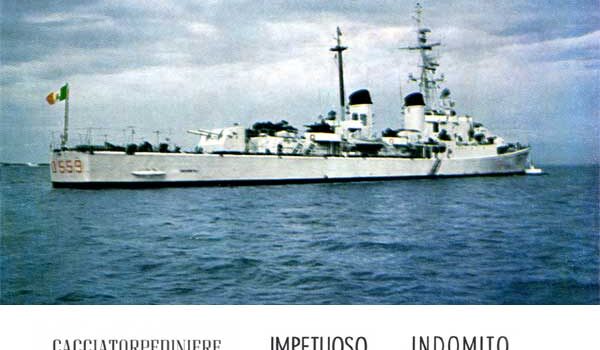

 Latest Facebook Entry -
Latest Facebook Entry -  X(Tweeter) Naval Encyclopedia's deck archive
X(Tweeter) Naval Encyclopedia's deck archive Instagram (@navalencyc)
Instagram (@navalencyc)





 French Navy
French Navy Royal Navy
Royal Navy Russian Navy
Russian Navy Armada Espanola
Armada Espanola Austrian Navy
Austrian Navy K.u.K. Kriegsmarine
K.u.K. Kriegsmarine Dansk Marine
Dansk Marine Nautiko Hellenon
Nautiko Hellenon Koninklije Marine 1870
Koninklije Marine 1870 Marinha do Brasil
Marinha do Brasil Osmanlı Donanması
Osmanlı Donanması Marina Do Peru
Marina Do Peru Marinha do Portugal
Marinha do Portugal Regia Marina 1870
Regia Marina 1870 Nihhon Kaigun 1870
Nihhon Kaigun 1870 Preußische Marine 1870
Preußische Marine 1870 Russkiy Flot 1870
Russkiy Flot 1870 Svenska marinen
Svenska marinen Søværnet
Søværnet Union Navy
Union Navy Confederate Navy
Confederate Navy Armada de Argentina
Armada de Argentina Imperial Chinese Navy
Imperial Chinese Navy Marinha do Portugal
Marinha do Portugal Mexico
Mexico Kaiserliche Marine
Kaiserliche Marine 1898 US Navy
1898 US Navy Sovietskiy Flot
Sovietskiy Flot Royal Canadian Navy
Royal Canadian Navy Royal Australian Navy
Royal Australian Navy RNZN Fleet
RNZN Fleet Chinese Navy 1937
Chinese Navy 1937 Kriegsmarine
Kriegsmarine Chilean Navy
Chilean Navy Danish Navy
Danish Navy Finnish Navy
Finnish Navy Hellenic Navy
Hellenic Navy Polish Navy
Polish Navy Romanian Navy
Romanian Navy Turkish Navy
Turkish Navy Royal Yugoslav Navy
Royal Yugoslav Navy Royal Thai Navy
Royal Thai Navy Minor Navies
Minor Navies Albania
Albania Austria
Austria Belgium
Belgium Columbia
Columbia Costa Rica
Costa Rica Cuba
Cuba Czechoslovakia
Czechoslovakia Dominican Republic
Dominican Republic Haiti
Haiti Hungary
Hungary Honduras
Honduras Estonia
Estonia Iceland
Iceland Eire
Eire Equador
Equador Iran
Iran Iraq
Iraq Latvia
Latvia Liberia
Liberia Lithuania
Lithuania Mandchukuo
Mandchukuo Morocco
Morocco Nicaragua
Nicaragua Persia
Persia San Salvador
San Salvador Sarawak
Sarawak Uruguay
Uruguay Venezuela
Venezuela Zanzibar
Zanzibar Warsaw Pact Navies
Warsaw Pact Navies Bulgaria
Bulgaria Hungary
Hungary

 Bundesmarine
Bundesmarine Dutch Navy
Dutch Navy Hellenic Navy
Hellenic Navy Marina Militare
Marina Militare Yugoslav Navy
Yugoslav Navy Chinese Navy
Chinese Navy Indian Navy
Indian Navy Indonesian Navy
Indonesian Navy JMSDF
JMSDF North Korean Navy
North Korean Navy Pakistani Navy
Pakistani Navy Philippines Navy
Philippines Navy ROKN
ROKN Rep. of Singapore Navy
Rep. of Singapore Navy Taiwanese Navy
Taiwanese Navy IDF Navy
IDF Navy Saudi Navy
Saudi Navy Royal New Zealand Navy
Royal New Zealand Navy Egyptian Navy
Egyptian Navy South African Navy
South African Navy






























 Ukrainian Navy
Ukrainian Navy dbodesign
dbodesign